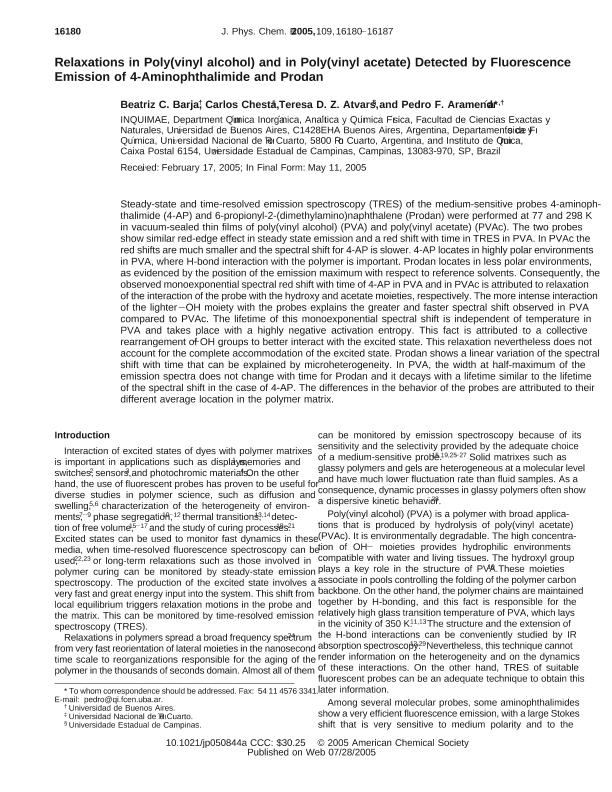Mostrar el registro sencillo del ítem
dc.contributor.author
Barja, Beatriz Carmen

dc.contributor.author
Chesta, Carlos Alberto

dc.contributor.author
Atvars, Teresa D. Z.
dc.contributor.author
Aramendia, Pedro Francisco

dc.date.available
2020-04-23T13:50:14Z
dc.date.issued
2005-08
dc.identifier.citation
Barja, Beatriz Carmen; Chesta, Carlos Alberto; Atvars, Teresa D. Z.; Aramendia, Pedro Francisco; Relaxations in Poly(vinyl alcohol) and in Poly(vinyl acetate) Detected by Fluorescence Emission of 4-Aminophthalimide and Prodan; American Chemical Society; Journal of Physical Chemistry B; 109; 33; 8-2005; 16180-16187
dc.identifier.issn
1520-6106
dc.identifier.uri
http://hdl.handle.net/11336/103408
dc.description.abstract
Steady-state and time-resolved emission spectroscopy (TRES) of the medium-sensitive probes 4-aminophthalimide (4-AP) and 6-propionyl-2-(dimethylamino)naphthalene (Prodan) were performed at 77 and 298 K in vacuum-sealed thin films of poly(vinyl alcohol) (PVA) and poly(vinyl acetate) (PVAc). The two probes show similar red-edge effect in steady state emission and a red shift with time in TRES in PVA. In PVAc the red shifts are much smaller and the spectral shift for 4-AP is slower. 4-AP locates in highly polar environments in PVA, where H-bond interaction with the polymer is important. Prodan locates in less polar environments, as evidenced by the position of the emission maximum with respect to reference solvents. Consequently, the observed monoexponential spectral red shift with time of 4-AP in PVA and in PVAc is attributed to relaxation of the interaction of the probe with the hydroxy and acetate moieties, respectively. The more intense interaction of the lighter -OH moiety with the probes explains the greater and faster spectral shift observed in PVA compared to PVAc. The lifetime of this monoexponential spectral shift is independent of temperature in PVA and takes place with a highly negative activation entropy. This fact is attributed to a collective rearrangement of -OH groups to better interact with the excited state. This relaxation nevertheless does not account for the complete accommodation of the excited state. Prodan shows a linear variation of the spectral shift with time that can be explained by microheterogeneity. In PVA, the width at half-maximum of the emission spectra does not change with time for Prodan and it decays with a lifetime similar to the lifetime of the spectral shift in the case of 4-AP. The differences in the behavior of the probes are attributed to their different average location in the polymer matrix.
dc.format
application/pdf
dc.language.iso
eng
dc.publisher
American Chemical Society

dc.rights
info:eu-repo/semantics/openAccess
dc.rights.uri
https://creativecommons.org/licenses/by-nc-sa/2.5/ar/
dc.subject
polymer
dc.subject
PRODAN
dc.subject
4-aminophthalimide
dc.subject
relaxation
dc.subject.classification
Físico-Química, Ciencia de los Polímeros, Electroquímica

dc.subject.classification
Ciencias Químicas

dc.subject.classification
CIENCIAS NATURALES Y EXACTAS

dc.title
Relaxations in Poly(vinyl alcohol) and in Poly(vinyl acetate) Detected by Fluorescence Emission of 4-Aminophthalimide and Prodan
dc.type
info:eu-repo/semantics/article
dc.type
info:ar-repo/semantics/artículo
dc.type
info:eu-repo/semantics/publishedVersion
dc.date.updated
2020-04-22T14:47:13Z
dc.identifier.eissn
1089-5647
dc.journal.volume
109
dc.journal.number
33
dc.journal.pagination
16180-16187
dc.journal.pais
Estados Unidos

dc.description.fil
Fil: Barja, Beatriz Carmen. Universidad de Buenos Aires. Facultad de Ciencias Exactas y Naturales. Departamento de Química Inorgánica, Analítica y Química Física; Argentina. Consejo Nacional de Investigaciones Científicas y Técnicas. Oficina de Coordinación Administrativa Ciudad Universitaria. Instituto de Química, Física de los Materiales, Medioambiente y Energía. Universidad de Buenos Aires. Facultad de Ciencias Exactas y Naturales. Instituto de Química, Física de los Materiales, Medioambiente y Energía; Argentina
dc.description.fil
Fil: Chesta, Carlos Alberto. Universidad Nacional de Río Cuarto; Argentina. Consejo Nacional de Investigaciones Científicas y Técnicas; Argentina
dc.description.fil
Fil: Atvars, Teresa D. Z.. Universidade Estadual de Campinas; Brasil
dc.description.fil
Fil: Aramendia, Pedro Francisco. Consejo Nacional de Investigaciones Científicas y Técnicas. Oficina de Coordinación Administrativa Ciudad Universitaria. Instituto de Química, Física de los Materiales, Medioambiente y Energía. Universidad de Buenos Aires. Facultad de Ciencias Exactas y Naturales. Instituto de Química, Física de los Materiales, Medioambiente y Energía; Argentina. Universidad de Buenos Aires. Facultad de Ciencias Exactas y Naturales. Departamento de Química Inorgánica, Analítica y Química Física; Argentina
dc.journal.title
Journal of Physical Chemistry B

dc.relation.alternativeid
info:eu-repo/semantics/altIdentifier/doi/http://dx.doi.org/10.1021/jp050844a
dc.relation.alternativeid
info:eu-repo/semantics/altIdentifier/url/https://pubs.acs.org/doi/10.1021/jp050844a
Archivos asociados
